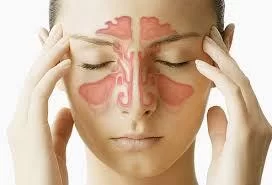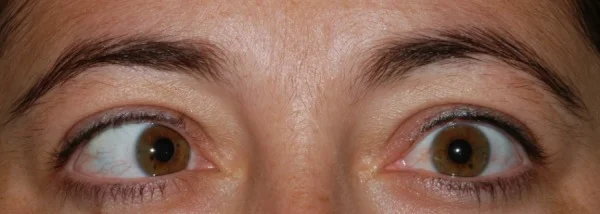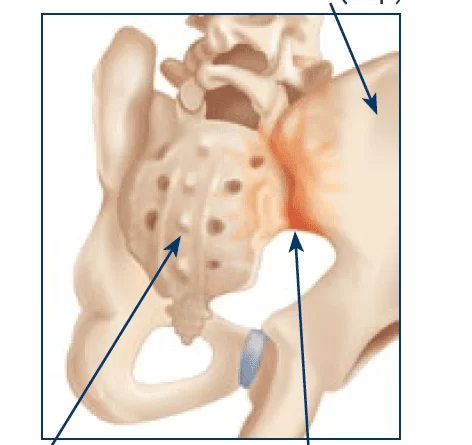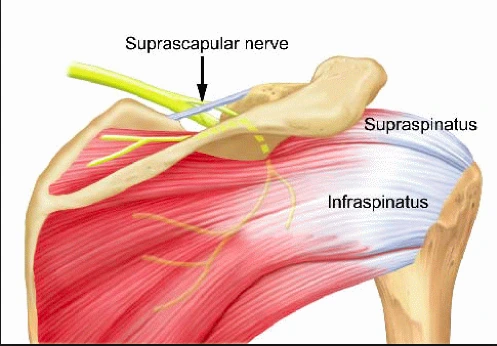Sinusitis (Sinus Infection)
Table of Contents
Introduction
Sinusitis is an inflammation of the tissues in your sinuses (air-filled areas in your forehead, cheeks, and nose). It causes facial pain, stuffy or runny nose, fever, and other symptoms. Sinusitis is typically caused by the common cold, but it can also be caused by other viruses, bacteria, fungi, or allergies.
When the tissue lining the sinuses swells or becomes inflamed, sinusitis is present. It manifests as a result of an inflammatory response or an infection with a virus, bacterium, or fungus.
The sinuses are little air sacs that are found between the eyes, behind the cheekbones, and on the forehead and nose. Inflammation of the sinuses and nasal passages is referred to as sinusitis.
Inflammation may be brought on by a sinus infection or structural issues with the nose. The phrases “sinusitis” and “sinus infection” are sometimes used similarly.
It’s fairly usual to get a sinus infection. According to the American College of Asthma, Allergy, and Immunology, 31 million Americans suffer from sinus infections each year.
What is sinusitis (sinus infection)?
Sinusitis is a swelling or inflammation of the tissue lining your sinuses. Sinuses are hollow structures inside your face that ordinarily contain air. Bacterial infections, viral infections, and allergies can cause them to become irritated, causing them to get clogged and filled with fluid. This might result in facial discomfort and pain, nasal congestion (a stuffy nose), and other symptoms.
Sinusitis is also known as rhinosinusitis.
What are sinuses?
The sinuses are four pairs of cavities (spaces) in your skull. They are linked by narrow canals. Sinuses produce mucus, which drains from the nasal passages. This drainage aids in the removal of bacteria, allergies, and other germs (pathogens) from your nose.
Types of sinusitis
There are various forms of sinusitis, and they all present with the same signs and symptoms. The symptoms might range in intensity and length.
We categorize sinusitis based on how long it has been present (acute, subacute, chronic, or recurrent), what causes it (bacteria, virus, or fungus), and where it is located ( Maxillary sinus, Ethmoid sinuses, Frontal, Sphenoid sinus)
Acute sinusitis
The sinusitis that is acute lasts the least time.
It might last for up to four weeks. The symptoms of a viral infection brought on by a cold can normally linger up to 10 days.
Most episodes of acute sinusitis ultimately occur by viral infections, but seasonal allergies are another potential cause.
The symptoms of acute sinusitis (nasal congestion, discharge, facial pain/pressure, and impaired sense of smell) last for fewer than four weeks. Viruses, such as the common cold, frequently occur.
Subacute sinusitis
Symptoms of acute sinusitis can last for up to 12 weeks. This illness frequently co-occurs with bacterial infections or seasonal allergies.
Recurrent acute sinusitis
You must experience at least four acute sinusitis episodes in a 12-month period to diagnose recurrent acute sinusitis. Acute sinusitis episodes must endure for at least seven days each.
Chronic sinusitis
Chronic sinusitis symptoms persist for longer than 12 weeks. Fever is uncommon, and chronic sinusitis symptoms are frequently less severe than acute sinusitis symptoms.
In some situations, bacterial infection might be to blame. Additionally, persistent allergies or structural problems with the nose frequently coexist with chronic sinusitis.
Viral sinusitis:
A runny nose, sore throat, sneezing, nasal congestion, and coughing are some of the symptoms of viral sinusitis that are typically cold-like. Mucus can either be clear or have a little tint.
A viral infection is not treatable with antibiotics. The best course of action is to treat the symptoms as best you can, which includes getting as much rest as you can, being hydrated, utilizing saline nasal sprays, and taking over-the-counter painkillers and oral decongestants.
Virus-induced sinusitis normally goes away in 7–10 days.
Bacterial sinusitis:
Bacterial sinusitis is characterized by a nasal discharge that may be thick, green, or yellow. The nasal passages are enlarged, and post-nasal drip (mucus flow down the back of the throat) is possible. Additionally, pressure and pain in the face are possible.
If you have a bacterial sinus infection, you should visit your doctor so they may prescribe you antibiotics like amoxicillin. Most people with acute bacterial sinusitis react well to antibiotic treatment, and symptoms usually go away in 10–14 days.
Allergic sinusitis:
Allergy-related sinusitis can result in inflammation, which can expand the mucous membranes and cause nasal obstruction, which can obstruct normal sinus outflow. Chronic sinusitis frequently results from allergic sinusitis. Seasonal or year-round symptoms can occur, and they include:
sneezing and scratchy eyes, throat, or nose
runny (clear mucus) nose, postnasal drip, and nasal congestion
Antihistamines, avoiding allergic triggers, and, in some situations, allergy injections are all part of the treatment for allergic sinusitis.
Most occurrences of sinusitis are caused by viruses, such as those that cause the common cold. Bacteria can cause sinusitis or infect you after a viral sinus infection. If your runny nose, stuffy nose, and facial pain persist after 10 days, you may have bacterial sinusitis. Your symptoms may appear to ease, only to return and be worse than before. Antibiotics and decongestants are commonly used to treat bacterial sinusitis.
Fungal sinusitis:
Fungus-caused sinus infections are frequently more severe than other types of sinusitis. They are more prone to occur if your immune system is compromised.
Maxillary sinus:
One sinus is found within the bone of each cheek (in your cheeks) and is known as the maxillary sinus.
Ethmoid sinuses:
a honeycomb-like structure composed of 6-12 tiny sinuses placed beneath the bone of the inside corner of each eye (between your eyelids).
Frontal:
one sinus on each side, placed above the level of the eyes and nasal bridge (in the lower center of your forehead).
Sphenoid sinuses:
one on each side, behind the ethmoid sinuses (behind your nose).
Signs and symptoms of sinusitis
Common sinus infection symptoms include:
- Mucus pouring down your neck (postnasal drip).
- Thick yellow or green mucus inside with runny nose.
- Nose congestion.
- Facial pressure (especially around the nose, eyes, and brow). When you move your head or bend over, this may worsen.
- You may feel pressure or pain in your teeth.
- Ear discomfort or pressure.
- Fever.
- An unpleasant taste in your mouth or bad breath (halitosis).
- Cough.
- Headache.
- Tiredness.
It could be challenging for parents to recognize sinusitis in a child. Symptoms include:
symptoms of a cold that do not go away in 10 to 14 days
allergic symptoms that do not go away after taking medicine
a persistent cough a fever that is higher than 102.2°F (39°C), which is regarded as a high fever, and thick green or yellow nasal mucus
Causes of sinusitis
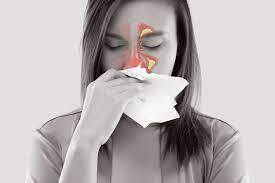
Spaces in the skull called sinuses are breathable. They can be found behind the brow, cheekbones, eyes, and nasal bones. In healthy sinuses, there are no microbes or other infections. Most of the time, air and mucus may travel through the sinuses.
Bacteria and other germs can thrive in congested nasal passages or when too much mucus builds.
Sinusitis can be caused by any of the following conditions:
The sinuses’ small hairs (cilia) are unable to adequately discharge mucus. Some medical issues could be to blame for this.
Allergies and colds may result in the production of excessive amounts of mucus or restrict the sinus opening.
Sinus entry can be obstructed by a deviated nasal septum, a nasal bone spur, or nasal polyps.
Mucosal edema and inflammation can be brought on by chronic infection.
The likelihood that an adult or child may get sinusitis may impact by the following:
- Hay fever or allergic rhinitis
- Dysplastic fibrosis
- boarding a nursery
- diseases that interfere with the cilia’s ability to function
- changes in height (when diving or flying)
- hefty adenoids
- Smoking
- the weak immune system brought on by the treatment of HIV
- abnormal sinus morphology
Sinusitis is usually caused by a virus that spreads from the upper airways to the sinuses. Only a few cases are caused by sinus infections caused by bacteria.
Inflammation of the sinuses can also be caused by an infected tooth or a fungal infection.
It’s unclear what causes sinusitis to become chronic (long-lasting), however, it’s been linked to: Allergies and associated disorders, such as allergic rhinitis, asthma, hay fever nasal polyps (growths inside the nose)
cigarette smoking weakens the immune system
Managing underlying illnesses like allergies and asthma may help to relieve the symptoms of chronic sinusitis.
Sinusitis risk Factors
When something, such as mucus, plugs the openings of your sinuses, sinusitis frequently results.
Anyone can get a sinus infection or get sinusitis. However, several medical issues and risk factors may raise your risk.
Sinusitis may result from various factors, such as:
- structural problems with the nose, such as a deviated septum, which happens when the tissue wall separating the left and right nostrils is uneven; a nasal bone spur, or protrusion; nasal polyps, which are often noncancerous; a compromised immune system.
- a background in allergens
- Colds and other upper respiratory tract illnesses that are brought on by bacteria, fungi, or viruses
- Due to cystic fibrosis, the linings of your mucous membranes, including those in your lungs, accumulate thick mucus.
- exposure to mold
- tobacco smoking
- oral infection
- Flying on an airplane might expose you to a lot of microorganisms.
- There are instances when a cold, allergies, or microorganisms might result in excessive mucus production. This mucus buildup can thicken and foster the growth of bacteria and other germs in your sinus cavity, which ultimately results in a sinus infection.
Sinusitis Diagnosis
A doctor will ask you about your symptoms and perform a physical examination before establishing a diagnosis. To check for pressure and soreness, they could press a finger against your head and cheeks. They could also look into your nose for inflammation-related signs.
The doctor may usually diagnose sinusitis based on your symptoms and the results of a physical examination.
If your sinusitis is persistent, the doctor might suggest imaging tests to examine your nasal passages and sinuses. These tests are capable of finding polyps as well as any other unusual growths, like mucus blockages.
Your basic care physician might also recommend a specialist, such as an otolaryngologist (commonly known as an ENT, or specialist in the ears, nose, and throat).
Your doctor may do the following tests to identify a sinus infection:
Image-based tests:
Several imaging studies can be used to get a diagnosis.
You can see your sinuses clearly on an X-ray.
A 3-D image of your sinuses can be obtained from a CT scan.
Strong magnets are used in an MRI to provide images of interior structures.
Nasal endoscopy:
Using a fiberscope, an illuminated tube that enters into your nose, the doctor can see the inside of your sinuses and nasal tubes clearly. A physician could take a sample during this procedure for culture testing. Cultures can be used to test for viruses, bacteria, or fungi.
Nasal swabs:
Your healthcare professional might take a fluid sample from your nose using a soft-tipped stick. They’ll evaluate it for any viruses or other microbes that might be causing your symptoms.
An allergy test:
Your doctor could do tests to see if you have any allergies that might be contributing to your chronic sinusitis.
Biopsy: On rare occasions, a doctor could extract a tissue sample from your nose for analysis.
Blood tests: A blood test can detect diseases like HIV that compromise the immune system.
Ciliary function test
Nasal culture
Nasal cytology
Sweat chloride tests for cystic fibrosis
How to Prevent Sinusitis?
Because sinusitis can develop following a cold, the flu, or an allergic reaction, leading a healthy lifestyle and minimizing your exposure to germs and allergens will help prevent this inflammation.
The easiest approach to avoid getting the flu or a cold is to seek immediate medical attention for any issues.
If you have allergies, manage them.
Get vaccinated against influenza annually.
Be less stressed.
Wash your hands frequently, especially after shaking someone else’s hand.
Additional advice for avoiding sinusitis:
Avoid pollution and smoking.
Drink a lot of liquids to make your body more moist.
When you have an upper respiratory infection, take decongestants.
Carefully and promptly handle allergies.
To add moisture to your sinuses and nose, use a humidifier.
Sinusitis Complications
Untreated sinusitis may result in uncommon consequences like:
meningitis is a potentially fatal illness that can harm the brain and spinal cord an abscess, a walled-off accumulation of pus in the sinus cavity
orbital cellulitis is an infection of the eyelid tissue and Bone infection (osteomyelitis).
When to Consult a Medical Professional
In the event that:
You get a cold that worsens after 7 days or your symptoms linger longer than 10 to 14 days.
You have a strong headache for which over-the-counter painkillers are ineffective.
You’re feverish.
Even after properly taking all of your antibiotics, you still get symptoms.
When you have a sinus infection, your eyesight may shift.
You do not necessarily have a sinus infection or require antibiotics just because you have a green or yellow discharge. Many persons who have this symptom fully recover without the need for antibiotics.
Sinusitis Treatment:
Since viral infections are the most common cause of sinusitis, therapy may not always be necessary. However, over-the-counter (OTC) drugs and home treatments could be able to reduce your symptoms.
nasal congestion
Nasal congestion is a typical sign of allergies and infections. Congestion can cause nasal discharge, facial pain, and headaches, despite the fact that it is not a significant medical disease.
Nasal congestion is one of the most typical sinusitis signs and symptoms. Try these recommendations to relieve nasal congestion:
To lessen sinus congestion, try the following techniques:
- Several times per day, gently wipe your face with a warm, damp washcloth.
- 2 to 4 times a day, inhale steam (for instance, while sitting in the shower in the bathroom).
- To clear the sinuses, use a Neti pot or saline squeeze bottle.
- Apply a warm, damp cloth to your cheek and forehead several times per day to assist ease sinus pressure pain.
- To assist clear the thick, sticky mucus from your nose, perform a nasal saline rinse.
- To stay hydrated and thin the mucus, drink water and juice. You can use a mucus-thinning over-the-counter drug like guaifenesin.
- To add moisture to the air in your bedroom, use a humidifier. To surround yourself with steam, turn on the shower and relax in the bathroom with the door closed.
- Use a nasal corticosteroid spray that is over-the-counter. Decongestants are sold over the counter, but before using one, you might want to talk to your doctor.
- Nasal congestion can be treated at home using the quick and easy procedure of sinus massage.
Pain medications
In rare instances, sinusitis can cause pressure in your forehead and cheeks or a sinus headache. If you’re in pain, over-the-counter drugs like acetaminophen (Tylenol) and ibuprofen (Advil, Motrin) can assist.
Antibiotics
You should visit a doctor if your symptoms don’t go away in a few weeks because you probably have a bacterial infection. If your symptoms, which include any of the following, do not improve, you could need antibiotic medication.
runny nose, congestion, coughing
facial pain or headaches for a prolonged period of time
eye swelling
You need to take an antibiotic for at least 10 to 14 days after obtaining it, depending on the doctor’s advice. Do not stop taking your medication before it is prescribed because doing so could cause the bacterial infection to worsen and possibly not completely go away.
Surgery for sinusitis
You may have surgery to If your chronic sinusitis does not get better with time and medicines,
Remove polyps,
Clean the sinuses,
Repair a deviated septum
Prognosis
The majority of sinus infections can be treated medically and at home. If you experience attacks often, you should have any suspected causes, such as nasal polyps or other conditions like allergies, examined.
Physiotherapy management for sinusitis
Short wave diathermy
Benefits of Short wave diathermy in Sinusitis are:
- Most effective
- Dilate arterioles
- Pain relief by removal of toxins
- Increase blood flow so increase in nutrition
Technique
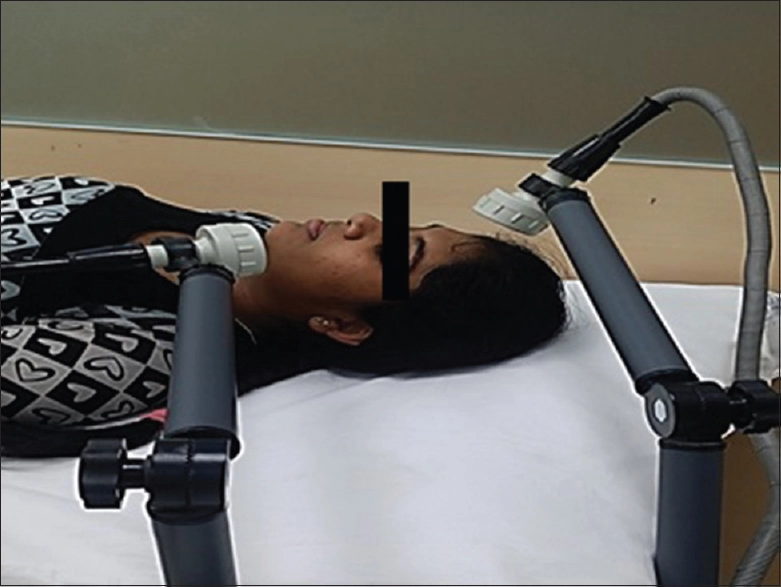
The cross-fire method is used to treat the walls of cavities containing air. E.g. maxillary sinus
The lines of force that pass through the tissue between electrodes are not treated
The position of the electrode is then changed to the right angle to the previous one and those walls are treated.
Electrode type
Butterfly-shaped/simple pad of 8cm.
Spacing: on the affected side= 2cm
on unaffected side= 3cm
Treatment of maxillary sinus with one 8cm electrode on the lateral part of the cheek and the other on the opposite side of the face below the angle of the jaw. algometer after the five therapy sessions were complete.
For patients with sinusitis, SWD using small disc electrodes in continuous mode at an intensity based on their tolerance as well as to induce the least amount of sinus heating possible. The maxillary and frontal sinuses are treated by using the conventional cross-fire technique.
Tell the patient to lie face down on the ground. One electrode is placed on the lateral section of the forehead for the treatment of all sinuses, and the second electrode is positioned on the opposite side of the face, below the angle of the jaw. After ten minutes of therapy, the electrode location is switched to the opposite side in order to heat the sinuses equally.
UVR:
Raises patient’s general resistance. The RF plays an important role in the body’s defense against infection. The cells of RF ingest bacteria and produce antibodies. It will lower the threshold of irritability of cells. so that more antibodies are produced in response to toxins. Ray must penetrate the epidermis hence wavelengths of >290mm are used.
Technique:
Choice of lamp: air-cooled mercury vapor lamp and kromayer lamp
Dose: generally E1 or E2 is given which increases blood supply and increases resistance to skin infection.
E1: on an alternate day
E2: twice a week
Breathing exercise:
Deep breathing exercises to increase the airflow.
Chest expansion
Accompanied by steam inhalation and humidification which makes the cough wet and loosens it.
Teach appropriate coughing
Zn ionization:
Nostrils are packed with tube gauze soaked in saline/zn sulfate.
A specialized zinc metal electrode is used.
Steam inhalation:
Tincture benznin
Eucalyptus oil
menthol
Therapeutic ultrasound therapy:
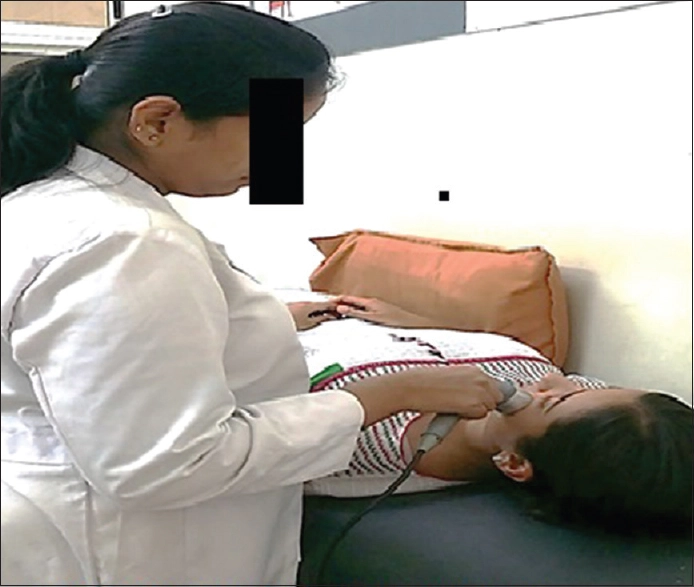
The mechanical vibration of molecules brought on by ultrasound therapy may facilitate and speed up the outflow of secretions, hence lowering pain.
Ask the patient to lie on the wooden plinth in a supine position. Standing at the patient’s head end, the therapist is attending to the patient. The patient receives continuous mode ultrasound therapy for the maxillary and frontal sinuses at a frequency of 1MHz and an intensity of 1 and 0.5 W/cm2, respectively. The skin above the cheekbones for the maxillary sinus and the forehead for the frontal sinus were the areas of application in the US. For a total of 5 minutes over the maxillary sinuses and 5 minutes over the frontal sinuses over each pair of sinuses, the portable US applicator is operate slowly and continuously in a circular motion. Between the applicator and the skin, there is an ultrasound transmission gel.
Physiotherapy can help the sinuses drain by using a variety of treatments, such as:
- Nebulization and ultrasound treatment
- Drainage and manual massage
- needle-dry needling
- Guidelines for lowering your exposure to environmental variables including pollens and poor posture.
Sinus massage:
Congestion in the nasal passages is a typical sign of allergies and infections. Despite not being a significant medical disease, congestion can cause nasal discharge, facial pain, and headaches.
The best treatments for nasal congestion are over-the-counter decongestants. However, those who have persistent congestion might want to try different therapies. People can treat nasal congestion at home with the quick and easy technique of sinus massage.
These guidelines will show you how to massage your sinuses to relieve nasal congestion.
What is sinus massage?
To relieve mucus buildup in the sinuses, a sinus massage employs mild pressure and heat from the fingers. It might aid in easing sinus congestion symptoms. Such signs might consist of:
ache and pressure in the face
headache, postnasal discharge that travels down the back of the neck, and a stuffy or runny nose
From the comfort of their own homes, people can swiftly and easily self-administer sinus massage.
Sinus massage techniques:
The four pairs of sinuses that make up the nasal passages are named after the facial bones that house them. One can massage all four pairs of sinuses at once, or one can just concentrate on the congested sinuses.
Here are some guidelines for massaging the various sinuses.
Frontal sinus massage
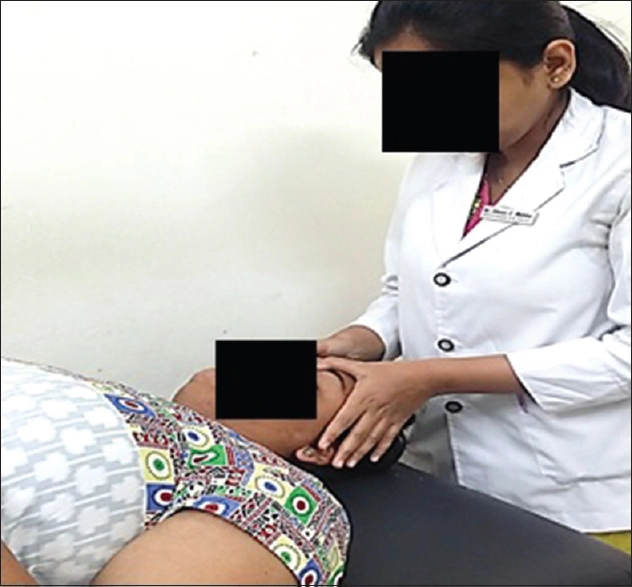
The top of the nose and the brow bone are connected by the frontal sinuses, which are located in the middle of the forehead.
Frontal sinus inflammation can cause excruciating pressure or pain in the forehead or behind the eyes.
Follow the steps listed below to massage the frontal sinuses:
- Rub the hands together or run them under warm water to make them warmer.
- Put the middle and index fingers of both hands on the brow bone’s midpoint.
- Moving outward towards the temples, gently rub the area.
- Massage in a circular motion outward towards the temples then returns to the center of the forehead.
- The massage should last for around 30 seconds.
Maxillary sinus massage
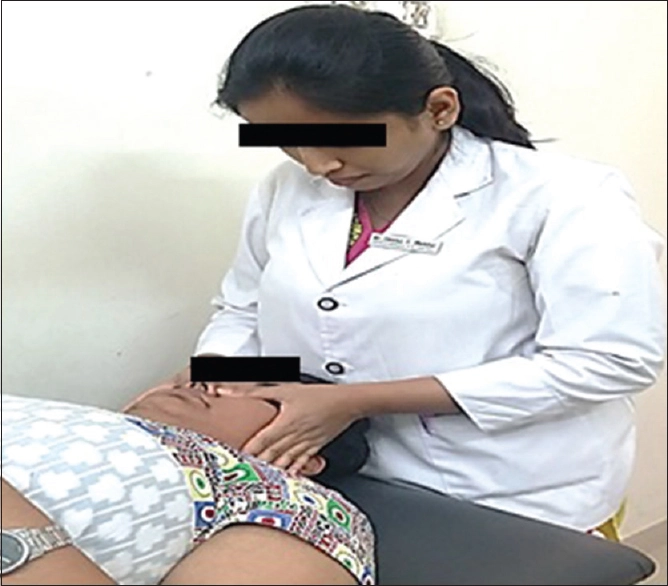
On either side of the nose, behind the cheeks, are the pyramid-shaped maxillary sinuses. They reach from the roof of the mouth to the base of the eyes.
Facial pain and postnasal discharge can result from maxillary sinus inflammation.
The steps listed below can be used to massage the maxillary sinuses:
- Put the index and middle fingers on either side of the nose, in the space between the top jaw and the cheekbones.
- Circularly massage the area with gentle pressure.
- The massage should last for around 30 seconds.
Sphenoid and ethmoid sinus massage
In the middle of the skull, between the eyes, and behind the nose are the sphenoid sinuses. In front of the sphenoid sinuses lie the ethmoid sinuses. They are located between the inner edge of the eye sockets and the bridge of the nose.
Headaches, face pain, and postnasal discharge can be caused by sphenoid and ethmoid sinus inflammation.
These procedures demonstrate how to successfully massage the sphenoid and ethmoid sinuses:
- Put your thumb and index finger on your nose’s bridge.
- For about 15 seconds, mild pressure should be applied to the region between the nose and the inner corners of the eyes.
- After that, keep pressing down while softly gliding your thumb and index finger along the sides of your nose.
- The slow, downward strokes should be repeated for around 30 seconds.
Exercise for Sinusitis:
Exercise can help reduce nasal congestion momentarily. The increased circulation relieves sinus pressure and makes breathing easier. With its cardio focus, an aerobic workout is especially effective at clearing congestion. Despite your desire to blend in with the bedding, moving provides the most relief. Lying down makes a stuffed nose worse. Sinuses do not have gravity to help them clear mucus-clogged cavities.
Increased core body warmth also helps to loosen sinus congestion. A runny nose may result, which, while irritating, improves sinus pressure and stuffiness. Carry tissues with you during your workout and you’ll have a clearer brain.
Force yourself to move, even if it’s only during your everyday routine. Shower right after waking up to loosen the mucus accumulation in your bronchial and nasal passages. You should be ready to lace up your trainers and travel to the Centre by then.
Breathing Exercises for sinusitis
Common symptoms of sinusitis and other respiratory diseases include blocked nostrils. Most of the time, the issue will go away on its own, but if a clogged nose is bothering you, you can try some breathing exercises and other treatments. If the issue persists or occurs frequently, you should also speak with a doctor about it. The correct therapy may be able to relieve an allergy or a physical obstruction, such as a polyp, that is restricting your nasal passageways.
You’re not alone if you’ve been suffering from the sniffles all winter. Winter not only brings on colds and sneezing fits that make us anxious, but it also makes our nostrils stuffy and blocked.
Because they help open clogged nasal passages, breathing exercises are one of the most natural therapies for sinus problems.
It is critical to perform daily nasal breathing exercises to clear your sinuses and lungs.
If your sinuses have been bothering you lately, you probably just want to be able to breathe normally once more. While there are numerous ways to clean your sinuses, we’ll focus on some breathing techniques today. The easiest method to begin your quest for sinus relief is to try breathing exercises because they are inexpensive and simple to complete.
Breathing Exercises to Clear a Blocked Nose
Performing the following exercise is one way to unclog a congested nose:
- Breathe normally and calmly. If possible, take a little, silent breath in through your nose for two seconds and a small, silent breath out through your nose for three seconds. If you can’t breathe in via your nose, take a small breath in from the corner of your lips.
- To hold your breath, pinch your nostrils with your fingers. Keep your mouth shut.
- Gently nod your head or move your body until you can no longer hold your breath.
- Hold your nose until you have a strong urge for air. Start slowly and gradually increasing your speed. Try to create a medium to severe air shortage without going over it.
- Normal, quiet breathing is required. Take a little, silent breath in through your nose for two seconds and a small, silent breath out through your nose for three seconds if possible. If you are unable to breathe in via your nose, take a little breath in from the corner of your lips.
- To hold your breath, pinch your nostrils with your fingers. Keep your mouth closed.
- Gently nod your head or move your body until you can’t hold your breath any longer.
- Hold your nose until you feel a strong want to breathe. Begin slowly and increase your speed progressively. Make a mild to severe air shortage without going over.
This breathing exercise can be performed anywhere and doesn’t need any particular equipment, making it an easy approach to relieving nasal blockages. Holding your breath can cause the nasal passageways to enlarge, which is why it works. To stop the blockage from recurring, attempt to breathe via your nose rather than your mouth. Mouth breathing can worsen a clogged nose by causing increased mucus production and airway constriction.
- Close your eyes and take a few short, deliberate breaths while sitting up straight with your shoulders back.
- Place your index fingers on your cheek’s and ear’s cartilage.
- Inhale deeply for three seconds via your nose.
- Gently press your ear cartilage to close your ears as you slowly exhale through your nose while humming like a bee. You can keep your ears closed at this point or press the cartilage in and out with each breath.
- About five to ten times, repeat steps three and four.
Based on an ancient yogic breathing technique (Bhramari pranayama), this humming breathing exercise is also referred to as the “bee breath” method. It has even been demonstrated to alleviate symptoms of chronic sinusitis. It is claimed to help quiet your mind and refocus your nerves. In addition to being employed in yoga sessions, this breathing method can also be used to reduce anxiety, relieve general stress, avoid tension and wrath, and generally calm an anxious mind.
In a manner similar to the first exercise, it functions as a breathing exercise for sinus relief by teaching your nasal passages to open up by slowly inhaling and exhaling through your nose.
Belly breathing:
This Belly Breathing Technique Is Essential for Calming Your Mind and Refocusing Your Nerves.
Belly breathing is a breathing technique that you may use at any moment to help you relax and clear your sinuses.
Taking a few calm, deep breaths via your abdomen rather than your mouth is the strategy.
Most people find it simpler to breathe through their stomach if they inhale deeply and exhale gently.
Deep Breathing exercise:
Deep Inhalation
By preventing air from becoming stuck in the lungs and facilitating the admission of more fresh air to the base of the lungs, deep breathing helps to reduce shortness of breath. The client might experience a calmer, more relaxed state as a result.
Technique:
Draw your elbows back a little while sitting or standing to let your chest expand.
Breathe deeply through your nose.
Hold your breath for five counts.
Take a deep breath in and slowly let it out through your nose.
Box Breathing:
Box breathing might be beneficial for relaxation. It is a breathing technique that can be used before, during, and/or after stressful encounters to help people manage stress. Visualize a voyage around the four sides of a square, pausing when traveling horizontally, and breathing in while traveling up the square and out while traveling down it. This practice can be done in a variety of settings and does not require a peaceful environment to be effective.
Procedure:

1: Take a four-count inhalation via the nose.
2: Hold your breath for five counts.
3: Exhale for four counts.
4: Hold your breath for five counts.
Repeat
Mindful Breathing:
Mindfulness meditation entails concentrating on your breathing and paying attention to the current moment without allowing your thoughts to wander to the past or future.
A calming focus is chosen to be repeated silently while the client inhales or exhales, which could be a sound (“om”), a positive word (“peace”), or a sentence (“breathe in calm, breathe out tension”).
The mind and body then relax and let go.
When the client feels their mind has wandered, they take a deep breath and gently bring their attention back to the current moment.
Cardio Exercise for The Sinuses
It is commonly known that engaging in a variety of cardiac workouts benefits the heart and overall well-being, but many people forget the fact that it also aids in the removal of toxins from the body. If you want to get rid of sinus problems, practice at least 30 minutes of cardio every day, whether you run outside or do yoga exercises inside.
Because exercise helps clear out your sinuses, it also helps clear out toxins that become trapped in your nasal passages. You should be alright as long as you get some cardiovascular exercise.
Other Remedies for Blocked Noses
Breathing exercises can typically help relieve a congested nose, although they are not always appropriate for everyone. Other alternatives you can try at home include:
Use an extra cushion when sleeping and remain in a more upright position during the day to reduce swelling and fluid buildup in your head
Massage your sinuses to help fluid to drain from them. You can accomplish this by making small circles with your index fingers down your brow, around your nose, under your eyes, and over your cheekbones. Work your way outwards from the nose with mild pressure. Apply a warm compress to your face, such as a moist cloth or a heated hot water bottle. It can aid in the opening of your nasal passages.
Take a hot bath or shower. Warm, moist air should assist to release mucus and alleviate nasal congestion. You can accomplish a similar effect by using a humidifier in your room.
Nasal sprays, saline solutions, mentholated salves, and decongestants are available over the counter. You can seek assistance from a chemist on how to utilize these medications.
If your nasal congestion is severe, isn’t improving, or keeps returning, consult a doctor to see if there’s an underlying problem that needs to be addressed.
Yoga for sinusitis:
Sinuses are empty spaces within the skull bone that are located around the nose, according to anatomy. The cells that line them produce mucus, a lubricant that keeps the sinuses from drying out. There are various efficient yoga poses for the sinuses that keep them healthy.
Although the precise role of the sinuses is unknown, it is thought that they contribute to the humidification of the air we breathe. By using techniques like nose exercises, yoga positions for the sinuses, avoiding excessive exposure to pollutants, etc., it is necessary to keep them healthy.
Yoga is a complete kind of exercise that has positive effects on a number of medical conditions. Yoga has a lot of advantages for sinus issues. With the use of yoga, patients who experience acute or recurrent attacks of sinusitis are likely to feel better. Some of the most efficient yoga asanas to treat sinus issues are listed below.
1. Adho Mukha Svanasana (Downward-facing dog pose)

Procedure: Come to all fours, knees hip-width apart, hands shoulder-width apart. Lift your hips slowly off the floor and straighten your elbows and knees. Make an inverted ‘V’ with your body. Now, press your hands into the ground and lengthen your neck so that your ears contact your inner arms and your sight is directed at your navel. Hold this position for 5–8 breaths before returning to the original position.
Benefits: One of the most beneficial yoga asanas for boosting blood circulation, clearing clogged channels, and relieving general body stress is the downward-facing dog stance. It not only stretches the neck and strengthens the spine, but it also decongests nasal canals and provides immediate sinus relief.

2. Salamba Sarvangasana (Shoulder-Stand Pose)
Procedure: Lie flat on the ground with your legs side by side and your arms on either side of your torso. Swing your legs up so that your legs, buttocks, and hips are in the air, and hold your body with your elbows on the ground. Hold your body appropriately while settling into the pose, keeping your legs and spine straight. Hold the stance for 30-40 seconds, breathing normally throughout. Return to the Shavasana stance by slowly lowering your legs and repeating it 2-3 times.
Benefits: Known as the “Mother of all Poses,” the shoulder stand stance is excellent for relieving stress and calming the mind. It not only relieves sinusitis and other allergy problems, but it also reduces sleeplessness and irritability. It even enhances blood flow in the lungs and aids in the body’s defense against infections.
3. Sethubandhasana (Bridge Pose)

Procedure: Begin the posture by resting on your back. Bend your knees and elbows now. Place your feet flat on the floor at your hips and your hands on either side of your head. Slowly lift your body into the air while supporting it with your hands and knees on the ground. Hold this crouched position for 20–30 seconds before gradually standing up.
Benefits: This is a great posture for not just alleviating arthritic pain but also for relieving tension and anxiety. Lifting the heart to a higher level stimulates the chest cavity, allowing oxygenated blood to easily fill the four chambers of the heart and aiding in sinus relief. It also helps to reduce allergies and sinus pressure by opening up the throat.

4. Matsya Asana (Fish Pose)
Procedure: Start by lying on your back with your palms positioned just behind your buttocks.
Straight and relaxed legs should be maintained at all times.
Elevate your chest and shoulders while drawing your elbows closer and taking a deep inhale.
Put your head on the ground and support your body weight with your elbows.
Shoulders should be arched back, and the neck should be fully extended.
Prior to returning to the initial resting position, continue your breathing gradually for another 5–10 counts.
Benefits: By extending and strengthening the lung muscles, the fish posture, often known as the “Destroyer of All Diseases,” encourages deep breathing. It unclogs congested pathways in the chest and throat, providing sinusitis relief. It is also important in treating allergy problems, improving circulation, and boosting overall immunity.
5. Bhujangasana (Cobra Pose)

Procedure: With your head on the ground, lie on your stomach. Keep your hands both by your shoulders, one on each side. Slowly push your palms together and lift your body up from the torso, extending your back and tummy muscles. Squeeze your shoulder blades into your back while keeping your arms straight. Hold this position for 15 to 30 seconds with your eyes fixed on a location on the ceiling, then breathe out and come back to the starting position.
Benefits: The cobra stance not only helps get rid of abdominal fat, but it also opens up the lungs and stimulates the heart. It is also a great stress reliever and one of the finest positions for sinus treatment because it stretches the lungs and makes breathing easier.
6. Anulom Vilom Pranayama
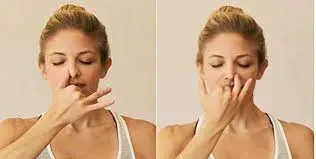
This pranayam is a breathing method that aids in the removal of nasal congestion. It promotes the free passage of air. It also promotes immunity and enhances blood flow to the brain. Perform this asana while your eyes are closed.
Procedure: Cross your legs on the floor while keeping your back straight.
On your left knee, place the left palm.
Take a big breath in through your left nostril while covering your right nose with your right thumb.
Release your right thumb at this point, and then seal your left nostril with your right ring finger.
To completely exhale the air from your right nostril, do so gradually and evenly.
Continue breathing in through your right nose while keeping your left nostril closed.
Release the ring finger, then use your thumb to cover your right nose.
Through your left nostril, fully exhale.
Continue doing this until you feel your sinuses clearing up.
7. Kapalbhati
In addition to clearing your sinuses, the breathing method known as kapalbhati also enhances your cognitive abilities. In kapalbhati, the exhalation is vigorous. Additionally, it helps you lose weight, heals colds and coughs, clears obstructions in your respiratory system, and improves memory.
In a quiet environment with no distractions, take a padmasana position and maintain a straight back.
Close your eyes and inhale deeply.
Exhale from your mouth while keeping it shut in short, rapid bursts until you run out of air.
Beginners can practice 60 exhalations per minute in repeats before increasing to 100 exhalations per minute.
Keep in mind to quit Kapalabhati as soon as you experience even minor discomfort.
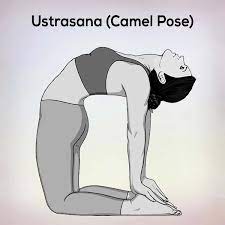
Another yoga stance that can help with sinusitis is ustrasana, sometimes known as the camel pose. It clears the congestion in your nasal passages. Additionally, it enhances eyesight and digestion.
Procedure: In a quiet environment with no distractions, take a comfortable seat and maintain a straight back.
Close your eyes and inhale deeply.
Exhale from your mouth while keeping it shut in short, rapid bursts until you run out of air.
Beginners can practice 60 exhalations per minute in repeats before increasing to 100 exhalations per minute.
Keep in mind to quit Kapalabhati as soon as you experience even minor discomfort.
9. Bhastrika Pranayama

Another breathing technique for treating sinusitis is bhastrika pranayama. In addition to treating a sore throat and a cold, it clears congestion. Additionally, it makes you more appetite.
Procedure: Put your palms on your knees and take a seat in padmasana or another comfortable position. Now inhale deeply and forcefully while holding your breath. Hold your breath for a few seconds before forcing a powerful exhalation. After a brief period of regular breathing, repeat the strong inhale and exhale. Ten times total.
10. Nadi Shodhan
It is essentially a breathing technique that is primarily used to eliminate obstructions from the body. Additionally, it releases accumulated stress and tiredness while also relaxing the mind. Steps–

First, take a seat comfortably with your back straight and your shoulders relaxed.
Keep your eyes closed and breathe slowly throughout the process.
Keep your left hand on your side’s knee with the palm facing up.
Put the tips of your right index and middle fingers in the space between your brows.
Put the thumb on the right nostril and the ring finger and tiny finger on the left nostril.
Gently exhale from the left nostril by pressing the thumb against it.
Gently inhale through the left nostril, then use your ring and little fingers to seal it.
Exhale through the right nostril, which is now open.
Do the same thing on the other side. The first cycle of Nadi Shodhan pranayama is complete.
At least nine times should be done at once.
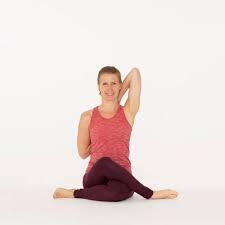
11. Gomukhasana (Cow Face Pose)
Gomukhasana, also known as the Cow Face Pose, was named after the cow because when performed, it mimics the animal’s face. ‘Go’ is a Sanskrit word that both denotes cow and light. The pose is a Vinyasa yoga pose for beginners. Practice it first thing in the morning on an empty stomach for best results. Maintain the position for 30 to 50 seconds.
Benefits Of The Sinusitis Pose- Gomukhasana eases tension and stress. It helps increase airflow flexibility by stretching the chest muscles. When you are anxious or exhausted, the pose might help you relax and relieve tension.
12. Janu Sirsasana (Head To Knee Pose)
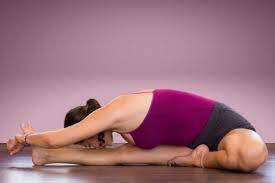
As the name of the pose says, Janu Sirsasana, also known as the Head to Knee Pose, calls for you to touch your head to your knee while seated. Beginners should do this Ashtanga yoga pose in the morning or evening on an empty stomach. Make sure you hold the position for at least 30 to 60 seconds on each leg.
The yoga posture of Janu Sirsasana encourages shoulder opening and calms the mind. Any head-down position will, particularly, facilitate airway cleaning and fluid drainage for better breathing. The posture promotes overall health by relieving headaches, exhaustion, and anxiety. The asana treats excessive blood pressure and sleeplessness, which might exacerbate your sinusitis problem.

13. Vajrasana
Procedure: Gently lie down on your mat.
Put your toes near one other and keep your heels close together.
Keep your palms facing up and on your knees.
Raise your shoulders and gaze upward.
Hold this pose for a few minutes.
14. Halasana
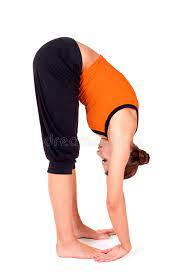
Procedure: Place your palms next to your body when you are lying on your back.
Put your palms on the ground and drop your legs behind your head to lift them up.
Using your palms, support the back.
Hold the pose for a few breaths.
15. Padahastasana
Procedure: Step one is to stand in Samasthiti.
Take a deep breath out, softly sway from the hips, and touch your nose to your knees.
Put both hands on the sides of your feet. You can slightly flex your knees in the beginning.
Practice slowly straightening your knees while attempting to contact your thighs with your chest.
16. Shavasana

Procedure: Lie on your yoga mat or a comfortable surface your yoga mat or a comfortable surface, and lie down in a prone position. We suggest lying down on a hard surface. Try to perform this pose in a calm environment to make sure there won’t be any disturbances.
Shut your eyes. Place your legs at a comfortable distance apart and let them fully relax.
Keep your toes pointed outward and let your ankles sink.
Your arms should be parallel to your body and spaced slightly apart. Make sure your palms are open to the sky and looking up.
Bring your awareness to every part of your body, beginning with your toes.
Take deep breaths to induce a deep state of relaxation in your body.
Keep your awareness up to avoid dozing off while working. Continue to breathe deeply and slowly. Imagine that your breath is energizing your body as you breathe in, and as you breathe out, your body is gradually giving in to relaxation.
17. Paschimottanasana
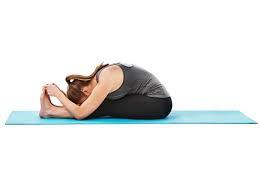
One of the yoga poses known as Paschimottanasana stretches and exercises practically all of the body’s muscles. One of the best yoga poses for a blocked nose is the seated forward bend.
Procedure: Stretch your legs out straight in front of you while keeping them parallel to one another.
Keep both arms at your sides, your back upright, and your toes on the ground.
While inhaling deeply, extend upward while lifting both arms in the air.
Now, while exhaling, bend your back forward and try to grip your toes.
Try to bend as much as you can without straining.
Wherever your hands can easily reach while bending, hold your legs at the toes, ankles, or shins.
Lifting your neck a little higher, hold it there for a while.
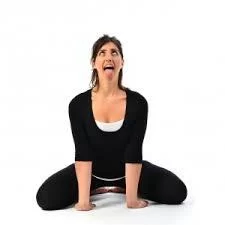
Lion is called Simha in Sanskrit. Simha Mudra Pranayama is appropriately named because when it is practiced, the facial expressions mimic those of a lion. Simha Mudra Pranayama helps to empty excess mucus discharge that may have built up inside, which has a therapeutic impact on clogged sinuses.
Procedure: Ideally on the floor, sit cross-legged or in any other comfortable position.
With all of your fingers outstretched, place your hands on the knee.
Deeply inhale slowly through your nose.
Make a loud ‘haa’ sound as you forcefully exhale through your mouth.
Extend the tongue as far as it will go as if trying to touch the chin.
Simha Mudra Pranayama can do it ten times at once.
By allowing the extra mucus discharges that build up in the sinuses to flow, these yoga asanas and breathing techniques help to treat sinus problems. There are numerous other advantageous yoga poses for sinus issues that support the maintenance of a healthy respiratory system. Doctors frequently urge patients who complain of recurrent sinus issues to practice yoga in addition to receiving conventional medical care for their health.
Yoga is one of the most effective natural cures to use if you dislike having medical procedures done or taking medication. It is perhaps the finest way to treat sinusitis. It assists in opening up the lungs, improving respiration, improving blood and oxygen flow, clearing the airways (by draining out the fluids), decreasing tension and anxiety, relieving headaches and weariness, and preventing allergic nose diseases. Include these asanas in your fitness regimen as well as deep breathing exercises or meditation to put an end to this annoying condition. To get the desired results, you should put forth persistent effort and be patient.
How to get rid of Sinusitis naturally?
There are several therapies that one should follow to remove the mucus from the sinuses in addition to performing the asanas mentioned above for treating sinusitis. As a result, the patient can heal more quickly.
Here are some things to think about:
- Take a steamy breath
The mucus won’t thicken if you keep your face warm and breathe in some steam. Eventually, the pressure eases as the mucus thins. For additional benefits, such as healing the infection, add some essential oils. - Nasal irrigation
By using this technique, any dried-up mucus and bacteria will be removed from the mucus linings and nasal airways. In general, nasal wash, a saltwater solution, or a neti pot can be used for nasal irrigation. - Take Quercetin
Quercetin is a naturally occurring compound that is high in antioxidants and is frequently found in onions, apples, and green tea. The herb works by lowering the histamine release that causes sinusitis. - Drink lots of water
Water maintains the moisture content of the mucus lining. As a result, the mucus can drain more quickly and the sinuses don’t become clogged.
FAQs
Although yoga may not be the most effective treatment for sinusitis, it can help you improve your condition immediately. Yoga has a good possibility of helping, but you must first speak with your doctor and enlist the aid of a yoga instructor.
To prevent and treat your sinusitis issue, do yoga at least once a day. It assists in opening up the lungs, improving respiration, improving blood and oxygen flow, clearing the airways (by draining out the fluids), decreasing tension and anxiety, relieving headaches and weariness, and preventing allergic nose diseases.
An efficient breathing technique for sinusitis is bhramari pranayama. It eases congestion and aids in the treatment of sinusitis.
Yes, anulom vilom helps treat sinus problems by relieving nasal congestion. Additionally, it enhances blood flow to the body and brain and immunity.
Yes. By removing congestion, kapalbhati effectively treats sinus problems while also enhancing brain function and blood flow throughout the body and help to clear blocked nasal passages
Sinusitis is a swelling or inflammation of the tissue lining your sinuses. Sinuses are hollow facial structures that typically hold air. Bacterial infections, viral infections, and allergies can cause them to become irritated, causing them to get clogged and filled with fluid. This might result in facial discomfort and pain, nasal congestion (a stuffy nose), and other symptoms. Conditions include structural problems in the nose or a sinus infection that can cause inflammation. The phrases “sinusitis” and “sinus infection” are sometimes used interchangeably.
Sinusitis categorize based on how long it has been present (acute, subacute, chronic, or recurrent), what causes it (bacteria, virus, or fungus), and where it is located ( Maxillary sinus, Ethmoid sinuses, Frontal, Sphenoid sinus).
To relieve mucus buildup in the sinuses, a sinus massage employs mild pressure and heat from the fingers. It might aid in easing sinus congestion symptoms. Such signs might consist of:
ache and pressure in the face
headache, postnasal discharge that travels down the back of the neck, and a stuffy or runny nose
From the comfort of their own homes, people can swiftly and easily self-administer sinus massage.
The transmission of a cold or flu virus from the upper airways to the sinuses is a common cause of sinusitis. Few cases are brought on by sinus infections brought on by bacteria.
The sinuses can occasionally become inflamed due to a dental infection or fungus.
nasal polyps (growths within the nose), allergic rhinitis, asthma, and other hay fever-related diseases, smoking, weakens the immune system
Exercise can help reduce nasal congestion momentarily. The increased circulation relieves sinus pressure and makes breathing easier. With its cardio focus, an aerobic workout is especially effective at clearing congestion. Despite your desire to blend in with the bedding, moving provides the most relief. Lying down makes a stuffed nose worse. Sinuses do not have gravity to help them clear mucus-clogged cavities.
Increased core body warmth also helps to loosen sinus congestion. A runny nose may result, which, while irritating, improves sinus pressure and stuffiness.
The greatest forms of exercise for sinus relief may include yoga and other light activities like pilates and short-distance walks. As previously mentioned, yoga can assist in blood vessel contraction, which lowers sinus pressure and congestion.
Additionally, breathing exercises are one of the most natural treatments for sinus issues because they help to clear blocked nasal passages.
Draw your elbows back a little while sitting or standing to let your chest expand.
Breathe deeply through your nose.
Hold your breath for five counts.
Deeply inhale, then slowly exhale through your nose.
The mechanical vibration of molecules bring on by ultrasound therapy may facilitate and speed up the outflow of secretions, hence lowering pain. It helps to remove mucus from congested sinuses.

